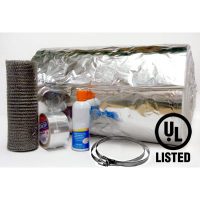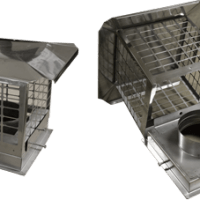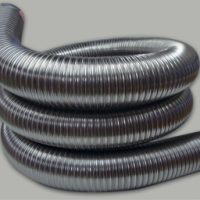Chimney liner metal alloys range from 304L to AL-29-4C. What is all this about? Keep in mind these different types of stainless steels are alloy differences. It has nothing to do with the actual thickness of the metal. In this article we will explain the multiple options you have in choosing chimney liner metal and which one to use in different circumstances. You have to be very careful when choosing a chimney liner. Different metals are made for different appliances and fuel combinations.
The name stainless steel originates from the fact that stainless steel does not stain, corrode or rust as easily as ordinary steel. It is also the term for grades of steel that contain more than 10% chromium with or without other alloying elements.
Stainless steel resists corrosion, maintains it’s strength at high temperatures and is easily maintained. For these reasons, it is used widely in items such as automotives, home and food processing products, as well as medical and health equipment. The most common types of stainless used in the chimney liner industry are: 304L; 316L; 316Ti; AL 29-4C.
Click Here to Buy Flexible Chimney Liner
316TI Stainless Steel
316TI is a stainless steel alloy with a small amount of titanium added. It’s make-up allows it to resist acids and the stresses of hot and cold cycles. It can be used with solid fuels (wood, coal and pellet), gas and oil. It can withstand temperatures up to 2100 degrees and still maintain a measure of strength.
316L Stainless Steel
316L chimney liner metal is commonly found in some thicker flexible chimney liners as well as in rigid chimney liners. The titanium is left out because of the added thickness of liners made from 316L stainless steel. 316L stainless steel is acceptable for use with coal, wood, gas or oil systems.
304L Stainless Steel
304L is best for chimneys liners venting a wood burning appliance. This alloy is commonly found in rigid chimney liner.
It accounts for more than half of the stainless steel produced in the world. This grade withstands ordinary corrosion in architecture, is durable in typical food processing environments and resists most chemicals.
Al 29-4C Stainless Steel
This chimney liner metal alloy is used most often when relining a masonry chimney or clay lined chimney that will vent a modern high efficiency gas or oil furnace of 83% efficiency or higher.
It is an alloy of stainless steel that is highly resistant to corrosion. It is used for relining chimney flues where flue gases may contain highly corrosive elements. It is especially important to use an AL 29-4c chimney liner if venting an appliance which is burning corn. Since most of the heat generated by such a high efficiency appliance goes into the home, the flue gas temperatures tend to be relatively low.
Click Here to Buy Flexible Chimney Liner
Low flue gas temperatures keeps moisture in the flue gases from evaporating and being eliminated up the flue. The combination of moisture in the flue gas along with other chemicals that may be inducted into the flue from the surrounding environment, such as those from chemical cleaners and laundry supplies, can contribute to a very corrosive flue gas composition.
AL29-4C is made to resist such corrosive environments over a long period of time.






